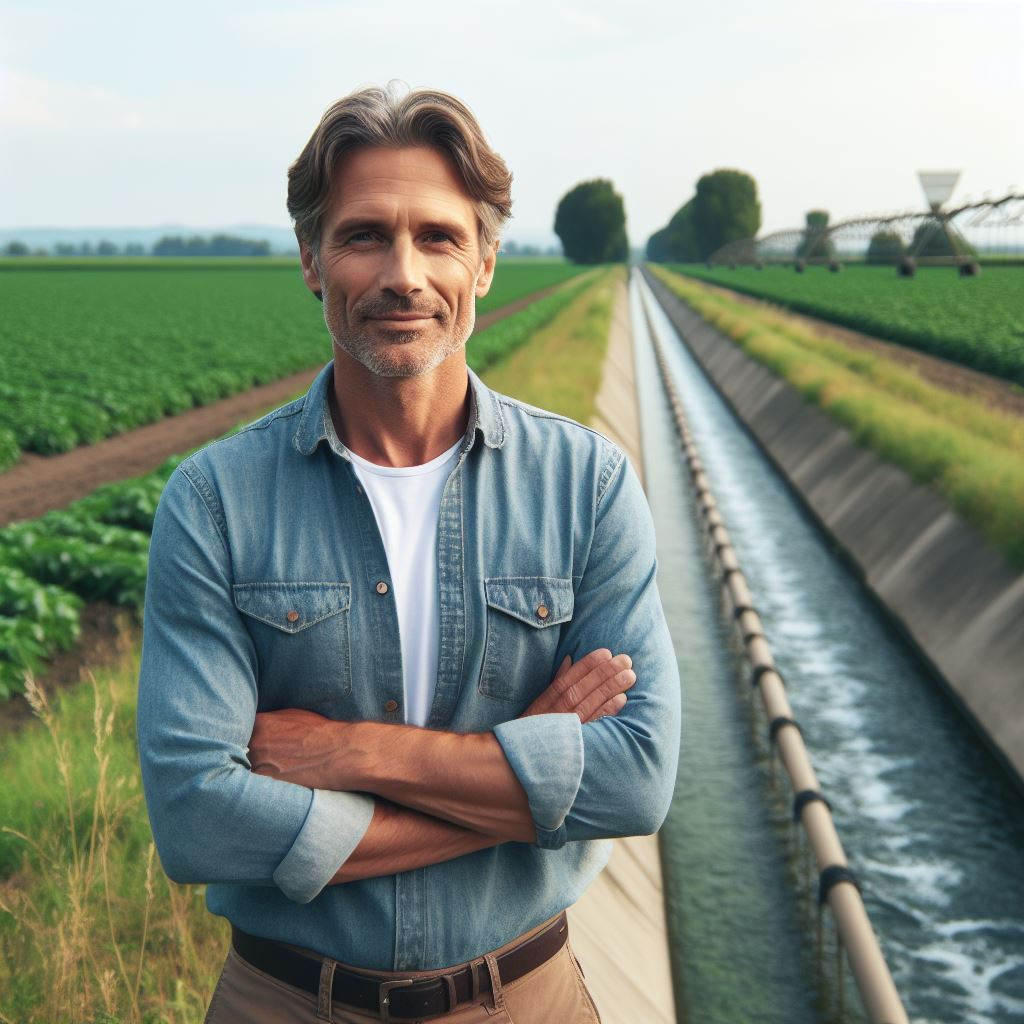Introduction
Irrigation is crucial for successful urban farming, and water-wise techniques can help conserve water.
Urban farming is gaining popularity as people are becoming more conscious about their food sources.
Growing crops in urban settings can help reduce the carbon footprint associated with food transportation and provide access to fresh produce in densely populated areas.
However, urban farming comes with its own set of challenges, and irrigation is one of them.
Proper irrigation is essential to ensure that crops receive the right amount of water to grow and thrive.
Overwatering can lead to water wastage, nutrient leaching, and the growth of weeds, while under-watering can cause crop stress and reduced yields.
To address these challenges, water-wise techniques are employed in urban farming. These techniques focus on maximizing the efficiency of water usage and minimizing wastage.
Drip irrigation systems can be installed to deliver water directly to the roots of plants, reducing evaporation and ensuring targeted irrigation.
Mulching, using organic matter like straw or compost, can help retain moisture in the soil and prevent evaporation.
Another water-wise technique is rainwater harvesting. Rain barrels or storage tanks can collect rainwater from rooftops, which can then be used for irrigation purposes.
This not only saves water but also reduces the strain on municipal water supplies.
Furthermore, crop selection plays a vital role in water-wise urban farming.
Choosing drought-tolerant plants, such as succulents or certain varieties of vegetables, can reduce water consumption.
Companion planting, where plants with similar water needs are grouped together, can also optimize irrigation.
In short, proper irrigation is essential for successful urban farming. By implementing water-wise techniques and selecting appropriate crops, urban farmers can conserve water and ensure efficient and sustainable food production.
Transform Your Agribusiness
Unlock your farm's potential with expert advice tailored to your needs. Get actionable steps that drive real results.
Get StartedUnderstanding Water Needs in Urban Farming
Unique Challenges of Water Management in Urban Areas
To achieve sustainable water management in urban farming, it is essential to understand the unique challenges that arise in urban areas.
Limited availability of water sources is a significant concern due to urbanization and population density.
As urban areas grow, the competition for water resources from various sectors increases, putting additional pressure on water availability for agricultural purposes.
Furthermore, the risk of water contamination in urban areas is higher due to pollutants from industrial activities and other sources.
This contamination poses a threat to crop health and the overall safety of urban farming produce.
The Importance of Assessing Water Requirements for Different Crops
One of the primary reasons for assessing water requirements for different crops is to optimize irrigation practices.
Understanding the specific water needs of each crop allows farmers to avoid over or under-watering, ensuring that the crops receive the right amount of water for healthy growth.
Overwatering can lead to the leaching of nutrients, water wastage, and the development of diseases, while under-watering can cause stunted growth, reduced yield, and crop failure.
By assessing water requirements, farmers can improve water use efficiency and reduce wastage.
This not only conserves water but also has economic benefits by reducing water bills and operational costs.
Farmers can utilize water-saving techniques such as drip irrigation or precision sprinklers to target water directly to the crop’s root zone, maximizing water use efficiency.
The Role of Climate and Specific Environmental Factors in Water Needs
Climate and specific environmental factors also play a crucial role in determining water needs for urban farming.
Climate factors such as temperature, humidity, wind, and evaporation influence crop water requirements.
Certain crops have different tolerance levels to drought or excess moisture, further highlighting the importance of understanding their specific water needs.
Soil characteristics, including type, structure, and depth, affect water retention and availability for crops.
Sandy soils, for example, drain water quickly, requiring more frequent irrigation, while clay soils retain water for longer periods.
Understanding soil moisture levels helps farmers adjust irrigation schedules accordingly.
Rainfall patterns and the availability of natural water sources are additional factors to consider when planning urban farming irrigation.
Incorporating rainwater harvesting systems or using reclaimed water can supplement irrigation needs while reducing the reliance on municipal water sources.
In fact, understanding water needs in urban farming is crucial for efficient water management.
By addressing the unique challenges of water scarcity, assessing crop-specific water requirements, and considering climate and environmental factors, sustainable irrigation practices can be implemented.
This not only ensures the viability and productivity of urban farming but also contributes to water conservation efforts in urban areas.
Read: Urban Beekeeping: Buzzing to Sustainability
Choosing the Right Irrigation System
In urban farming, choosing the right irrigation system is crucial for the success of your crops.
Showcase Your Farming Business
Publish your professional farming services profile on our blog for a one-time fee of $200 and reach a dedicated audience of farmers and agribusiness owners.
Publish Your ProfileDifferent types of irrigation systems have their own pros and cons, so it’s important to select the most efficient and appropriate system for your specific urban farming setup.
The various types of irrigation systems suitable for urban farming
Drip Irrigation
Drip irrigation is a popular choice for urban farmers due to its efficiency and ability to conserve water.
This system delivers water directly to the plant’s roots, reducing water waste and minimizing evaporation.
Pros
- Drip irrigation systems use less water compared to other methods.
- Water is targeted directly at the plant’s roots, preventing weed growth.
- Reduces the risk of diseases by keeping foliage dry.
- Can be easily automated, saving time and effort.
Cons
- Drip irrigation systems can be more expensive to set up initially.
- This system requires regular maintenance to ensure proper functioning.
- It may be challenging to detect clogged emitters or damaged tubing.
- Uneven water distribution can occur if not properly designed or installed.
Sprinkler Systems
Sprinkler systems are commonly used for larger urban farming areas and lawns.
These systems disperse water through overhead sprinklers, covering a wide area with water droplets.
Pros
- Sprinklers are easy to install and are available in a variety of designs.
- They provide uniform water distribution across a large area.
- Can be automated with timers and sensors for efficient watering.
- Sprinklers help cool plants in hot weather conditions.
Cons
- These systems can lead to water waste due to evaporation and wind drift.
- Some plants may be susceptible to fungal diseases with overhead watering.
- Water droplets can cling to foliage, promoting fungal growth.
- May require higher water pressure compared to other systems.
Choosing the Right System
When selecting the most efficient and appropriate irrigation system for your urban farming setup, consider the following tips:
- Assess your specific needs: Determine the size of your farming area and the types of plants you will be growing.
- Consider water source and availability: Evaluate the water source and availability, as some systems may require higher water pressure or flow.
- Factor in maintenance requirements: Consider the time and effort required for maintaining the system and whether it fits your schedule.
- Think about automation options: If you prefer automation, choose a system that can be easily automated with timers or sensors.
- Evaluate your budget: Consider the initial setup cost, as well as the long-term maintenance expenses.
- Seek expert advice: Consult with local irrigation specialists or experienced urban farmers to get recommendations tailored to your specific needs.
By carefully considering the pros and cons of different irrigation systems and following these tips, you can ensure your urban farming venture benefits from the most efficient irrigation system, leading to healthier and higher-quality yields.
Read: Indoor Farming: Techniques and Benefits
Water Conservation Techniques for Urban Farming
The significance of water conservation in urban farming
- Water conservation is crucial in urban farming to ensure sustainable agriculture.
- Due to limited water resources in urban areas, efficient water management becomes essential.
- Conserving water reduces reliance on municipal water supplies and helps mitigate drought conditions.
- Implementing water conservation techniques promotes ecological balance and minimizes environmental impact.
- Conserving water also lowers operational costs and promotes long-term viability of urban farming ventures.
Strategies such as recycling, rainwater harvesting, and greywater reuse
Recycling
- Implement a closed-loop system to recycle water within the urban farm.
- Collect and treat wastewater generated from farm operations for reuse in irrigation.
- Consider using innovative technologies like aquaponics to capture and reuse nutrient-rich water.
Rainwater Harvesting
- Install rain barrels or cisterns to capture rainwater from rooftops and other surfaces.
- Direct rainwater into a storage tank for later use in irrigation.
- Use gutter systems to channel rainwater into designated collection points on the farm.
Greywater Reuse
- Treat and reuse household greywater for irrigation purposes after safe filtration.
- Redirect greywater from sinks, showers, and washing machines into designated irrigation systems.
- Ensure proper filtration and treatment systems are in place to remove any harmful substances.
Practical tips on implementing water conservation techniques in urban farming operations
- Conduct a thorough water audit of your urban farm to identify areas of high water consumption.
- Establish a water conservation plan that outlines specific goals and strategies.
- Educate farm employees and volunteers on the importance of water conservation and best practices.
- Invest in efficient irrigation systems such as drip irrigation or micro-sprinklers to minimize water wastage.
- Monitor soil moisture levels regularly to avoid overwatering and ensure optimal plant health.
- Mulch the soil surface to reduce evaporation and maintain moisture levels.
- Choose drought-tolerant plant varieties suitable for your region and climate conditions.
- Implement organic farming practices that improve soil quality and water retention capabilities.
- Install water-efficient fixtures in farm buildings, such as low-flow toilets and faucets.
- Engage in community outreach programs to raise awareness about water conservation in urban farming.
Collaborate with local water conservation organizations and government agencies to access resources and support.
By adopting these water conservation techniques, urban farmers can play a significant role in preserving water resources, promoting sustainability, and ensuring the long-term success of their farming operations.
Read: Urban Composting: Turning Waste to Gold

Proper Irrigation Practices
When it comes to urban farming, proper irrigation practices are essential to ensure water efficiency and the successful growth of your crops.
Follow the tips below to make the most out of your water usage:
The Importance of Watering Deeply and Infrequently
It’s crucial to understand that watering deeply and infrequently is more beneficial than shallow and frequent watering.
Deep watering encourages plant roots to grow deeper into the ground, making them more resilient and better able to withstand drought conditions.
By allowing the soil to dry out slightly between waterings, you can also prevent waterlogging, which can lead to root rot and other water-related issues.
It’s essential to strike a balance between providing enough water and avoiding excess.
The Significance of Timing Irrigation Based on Plant Needs and Weather Conditions
Timing your irrigation properly is key to ensuring that your plants receive the water they need when they need it.
Different plants have different water requirements, so it’s crucial to understand their specific needs.
Pay attention to the daily weather forecast, especially during hot and dry periods.
If rain is expected, adjust your irrigation schedule accordingly to avoid overwatering.
Likewise, during cooler or rainy periods, reduce your watering frequency to prevent water wastage.
Avoiding Water Runoff and Wastage through Techniques like Mulching and Soil Moisture Monitoring
Water runoff can be a significant problem in urban farming, leading to the wastage of precious water resources.
To avoid runoff and conserve water, consider using mulching techniques and monitoring soil moisture levels.
Mulching with organic materials like straw or wood chips helps retain moisture in the soil by reducing evaporation.
This way, you can ensure that more water is absorbed by the plant roots, rather than being lost to the atmosphere.
Additionally, regularly monitoring soil moisture levels using soil moisture sensors or manually testing the soil’s moisture content can help you determine when to water.
This allows you to avoid watering unnecessarily when the soil is still moist enough, reducing water wastage.
Implementing these irrigation practices will not only help you conserve water but also promote healthier plant growth in your urban farm.
Remember to adjust your watering techniques based on the specific needs of your crops and the prevailing weather conditions.
With proper irrigation, you can maximize water efficiency and enjoy a bountiful harvest.
Read: Sustainable Soil Management in Cities
Monitoring and Adjusting Irrigation
Regularly monitoring soil moisture levels is essential to ensure efficient water use and the success of urban farming.
By understanding the moisture content in the soil, adjustments can be made to irrigation schedules, preventing overwatering or underwatering.
Necessity of Regularly Monitoring Soil Moisture Levels
Consistent monitoring of soil moisture levels allows farmers to optimize irrigation practices.
It helps determine if the soil has sufficient water content for proper plant growth or if irrigation is required.
Constantly checking soil moisture levels is important because it helps detect problems such as excessive evaporation, inefficient irrigation, or drainage issues.
These problems can lead to crop stress, reduced yield, and wasted water resources.
Using sensors and smart irrigation controllers provide accurate data on soil moisture levels, making monitoring more efficient.
These tools help determine the exact amount of water plants need, preventing water waste.
Showcase Your Farming Business
Publish your professional farming services profile on our blog for a one-time fee of $200 and reach a dedicated audience of farmers and agribusiness owners.
Publish Your ProfileUse of Sensors and Smart Irrigation Controllers for Efficient Water Management
Sensors placed within the soil measure soil moisture and trigger irrigation when levels reach a specific threshold.
These sensors eliminate the need for manual monitoring and reduce the risk of overwatering.
Smart irrigation controllers use advanced technology to automate watering based on factors such as weather conditions, soil moisture, and plant water requirements.
They ensure water is applied precisely, matching the specific needs of the plants at any given time.
These controllers can be programmed to adjust irrigation based on evapotranspiration rates, rainfall data, and plant growth stages.
By utilizing real-time data, smart controllers optimize water usage and prevent water runoff or wastage.
Guidance on Adjusting Irrigation Schedules
Adjusting irrigation schedules is crucial to ensure efficient water use and healthy plant growth.
Two factors to consider are plant growth stages and changing weather patterns.
During the early growth stages, when plants have shallow roots, frequent but shorter irrigation sessions may be required to maintain optimal soil moisture.
As plants mature and develop deeper roots, longer, less frequent irrigation sessions can be applied.
Monitoring weather patterns is crucial in adjusting irrigation schedules. In periods of rainfall, manual irrigation can be reduced or suspended temporarily to avoid waterlogging.
On the other hand, during hot and dry spells, irrigation frequency and duration should be increased.
Regularly reviewing and adjusting irrigation schedules according to the specific needs of the plants, soil moisture levels, and weather conditions can significantly improve water efficiency, conserve resources, and promote successful urban farming.
In brief, regular monitoring of soil moisture levels is vital for efficient water management in urban farming.
The use of sensors and smart irrigation controllers provides accurate data, preventing overwatering and improving water usage.
Adjusting irrigation schedules based on plant growth stages and changing weather patterns optimizes water efficiency and promotes healthy plant growth.
Troubleshooting Common Irrigation Issues
Identifying Common Problems in Urban Farming Irrigation
- Clogged emitters
- Leaks
- Inadequate water pressure
- Uneven water distribution
Urban farming irrigation systems are essential for sustaining agricultural practices in urban environments.
However, they can experience various issues that hinder their effectiveness.
By recognizing these common problems and understanding their potential causes, you can troubleshoot them effectively and ensure efficient irrigation for your urban farm.
Troubleshooting Tips for Resolving Irrigation Issues
- If you notice clogged emitters, carefully remove them and clean any debris or mineral buildup.
- Leaks can be caused by damaged pipes or fittings. Inspect your system regularly and repair or replace any faulty components.
- Inadequate water pressure may result from a damaged or undersized pump. Check your pump’s performance and consider upgrading if necessary.
- Uneven water distribution can be caused by improper sprinkler alignment or clogged nozzles. Adjust and clean your sprinklers to achieve uniform coverage.
Remember to always follow manufacturer’s instructions and ensure your safety when troubleshooting irrigation issues.
If you encounter complex problems or are unsure how to proceed, consult a professional irrigation technician for assistance.
Regular Maintenance Practices for Optimal Irrigation System Performance
- Inspect your irrigation system regularly to identify any potential issues before they escalate.
- Clear any vegetation or debris that may block or impede water flow in your irrigation lines.
- Check for leaks around valves, connectors, and fittings. Fix any leaks promptly to conserve water and prevent further damage.
- Flush your system periodically to remove sediment or mineral deposits that can clog emitters and reduce water flow.
- Ensure proper sprinkler alignment and operation. Adjust and clean sprinkler heads as needed to maintain uniform water distribution.
- Consider installing moisture sensors or smart irrigation controllers to optimize water usage and prevent over or under watering.
By implementing these regular maintenance practices, you can proactively prevent irrigation issues, extend the lifespan of your system, and maximize water efficiency in your urban farming operation.
In a nutshell, troubleshooting common irrigation issues in urban farming is crucial for maintaining optimal system performance.
Identifying problems like clogged emitters, leaks, and inadequate water pressure allows for effective resolution.
Regular maintenance practices further ensure the efficiency and longevity of your irrigation system, supporting the success of your urban farming endeavors.
Conclusion
By implementing water-wise practices in urban farming irrigation, we can ensure a sustainable and efficient use of water. The importance of these practices cannot be overstated.
Efficient irrigation techniques not only benefit crop health but also promote water conservation.
By minimizing water waste, we can contribute to the overall conservation of this precious resource.
Now, armed with these irrigation tips, it’s time for you, our readers, to make a difference in your own urban farming endeavors.
Be water-wise, be conscious of your irrigation practices, and strive to make a positive impact on the environment.
Remember, every drop counts. Let’s work together to create a future where urban farming thrives, and water resources are preserved for generations to come.




